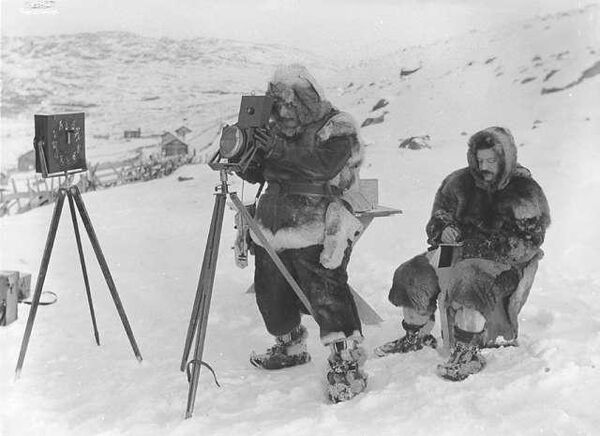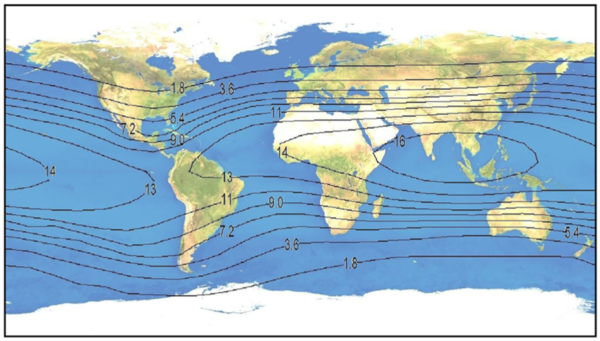Carl Størmer
From RHESSI Wiki
(Created page with "{{Infobox Nugget |name = Nugget |number = 429 |title = Carl Stoermer |first_author = Hugh HUDSON |second_author = Lyndsay FLETCHER |publish_date = 15 April 2022 |next_nugget = T...") |
(429 drafted, possibly conclusively) |
||
| Line 15: | Line 15: | ||
Kristian Birkeland (subject of an | Kristian Birkeland (subject of an | ||
[https://sprg.ssl.berkeley.edu/~tohban/wiki/index.php/Kristian_Birkeland earlier Nugget]) | [https://sprg.ssl.berkeley.edu/~tohban/wiki/index.php/Kristian_Birkeland earlier Nugget]) | ||
| - | in the illustrious history of Norwegian pioneers of | + | in the illustrious history of Norwegian pioneers of space weather. |
Both were active during the early years of 20th century | Both were active during the early years of 20th century | ||
[https://en.wikipedia.org/wiki/Oslo Oslo]. | [https://en.wikipedia.org/wiki/Oslo Oslo]. | ||
| - | Figure 1 shows a well-known picture featuring | + | Figure 1 shows a well-known picture featuring of him engaged in |
| - | photographing the aurora (Birkeland taking notes). | + | photographing the aurora (with Birkeland, but not the famous one, taking notes). |
This led to triangulation that demonstrated the high altitude of the | This led to triangulation that demonstrated the high altitude of the | ||
phenomenon, eliminating terrestrial explanations. | phenomenon, eliminating terrestrial explanations. | ||
The mystery here is that this famous photograph seems to have been taken | The mystery here is that this famous photograph seems to have been taken | ||
in broad daylight, not the best time to see the aurora. | in broad daylight, not the best time to see the aurora. | ||
| - | |||
| - | |||
| - | |||
| - | |||
| - | |||
This Nugget cannot add much to the existing biographies, but will touch on a | This Nugget cannot add much to the existing biographies, but will touch on a | ||
single scientific item. | single scientific item. | ||
| - | + | ||
| - | + | [[Image:429f1.jpg|600px|center|thumbnail|Figure 1: | |
| - | + | Størmer (standing) and his assistgant Birkeland (seated). | |
| + | ]] | ||
== The origins of cosmic rays == | == The origins of cosmic rays == | ||
| Line 45: | Line 41: | ||
(or [https://en.wikipedia.org/wiki/Rigidity_(electromagnetism) rigidity]) | (or [https://en.wikipedia.org/wiki/Rigidity_(electromagnetism) rigidity]) | ||
as it arrives from infinity and interacts with the dipole. | as it arrives from infinity and interacts with the dipole. | ||
| + | Intuitively it is clear that a particle with a sufficiently high rigidity will | ||
| + | penetrate the dipole field and precipitate the Earth. | ||
| + | The minimum such rigidity is called the "cutoff rigidity" and, not so | ||
| + | intuitively, the mapping of greater rigidities at a terrestrial point onto | ||
| + | the celestial sphere is not simple - the point becomes | ||
| + | a line parametrized by rigidity. | ||
| + | Modern calculations give results such as those in Figure 1 here, and are | ||
| + | routinely important for interpreting "cosmic ray" variations via | ||
| + | [https://en.wikipedia.org/wiki/Neutron_monitor neutron monitors] | ||
| + | in a network across the Earth. | ||
| + | Almost all of the variability comes not from the true cosmic rays, which | ||
| + | interested Størmer as an astronomer, but from solar particles and | ||
| + | geophysical matters, such as atmospheric pressure fluctuations. | ||
| + | |||
| + | [[File:429f2.png|600px|thumb|center|<b>Figure 1:</b> | ||
| + | Map of cutoff rigidities, ranging up to more than 16 GV. | ||
| + | The neutron monitor at Doi Inthanon, Thailand, is in the highest contour | ||
| + | and has a cutoff rigidity of about 17 GV. | ||
| + | ]] | ||
| + | |||
| + | == Størmer's Calculations == | ||
| + | |||
| + | The actual calculations (Ref. [1] and elsewhere) can only be described | ||
| + | as mathematically horrific. | ||
| + | Because most of the computational work was done by hand, Størmer devoted | ||
| + | great effort mathematically to re-casting the differential equations into | ||
| + | forms that lent themselves to basically manual numerical work. | ||
| + | Nevertheless, he and his helpers solved the problem for the idealized dipole; | ||
| + | nowadays it is solved repeatedly for realistic geomagnetic and interplanetary | ||
| + | magnetic fields, allowing for their time variations. | ||
| + | As a byproduct, he anticipated the later discovery of the | ||
| + | Van Allen Belts | ||
| + | (see Ref. [2] for a full historical account as of 1968). | ||
| + | Figure 3 reproduces a Størmer graphic showing one of his "forbidden | ||
| + | zones" - extraterrestrial cosmic rays cannot get into these volumes, but | ||
| + | conversely they form (ideally) permanent traps for particles. | ||
| + | In hindsight, one might have known that these horrible calculations led to | ||
| + | an extremely interesting prediction. | ||
| + | |||
| + | [[File:429f3.png|400px|thumb|center|<b>Figure 3:</b> | ||
| + | A Størmer forbidden zone, showing the characteristic mirroring | ||
| + | motions of a particle that cannot escape; in 3d this zone becomes a torus | ||
| + | ("belt") surrounding the Earth and in the | ||
| + | [https://en.wikipedia.org/wiki/Adiabatic_invariant adiabatic limit] | ||
| + | indeed particles are trapped in these belts. | ||
| + | ]] | ||
== Conclusion == | == Conclusion == | ||
| - | This concludes our series of RHESSI Nuggets on Norwegian pioneers of | + | This probably concludes our series of RHESSI Nuggets on Norwegian pioneers of |
| - | heliophysics. | + | heliophysics, although there are |
| + | [https://en.wikipedia.org/wiki/Svein_Rosseland Rosseland] and others | ||
| + | to think about. | ||
| + | We've only touched on one of Størmer's contributions, but it was | ||
| + | a fundamental one. | ||
== References == | == References == | ||
| - | [1] | + | [1] [1937ApNr....2..193S "On the Trajectories of Electric Particles..."] |
| + | |||
| + | [2] [https://www.osti.gov/includes/opennet/includes/Understanding%20the%20Atom/Space%20Radiation.pdf "Space Radiation", by W.R. Corliss] | ||
Revision as of 12:39, 20 May 2022
| Nugget | |
|---|---|
| Number: | 429 |
| 1st Author: | Hugh HUDSON |
| 2nd Author: | Lyndsay FLETCHER |
| Published: | 15 April 2022 |
| Next Nugget: | TBD |
| Previous Nugget: | Solar Hard X-rays with Insight |
| List all | |
Contents |
Introduction
Carl Størmer (1874-1957) followed Kristian Birkeland (subject of an earlier Nugget) in the illustrious history of Norwegian pioneers of space weather. Both were active during the early years of 20th century Oslo. Figure 1 shows a well-known picture featuring of him engaged in photographing the aurora (with Birkeland, but not the famous one, taking notes). This led to triangulation that demonstrated the high altitude of the phenomenon, eliminating terrestrial explanations. The mystery here is that this famous photograph seems to have been taken in broad daylight, not the best time to see the aurora. This Nugget cannot add much to the existing biographies, but will touch on a single scientific item.
The origins of cosmic rays
Størmer solved the difficult mathematical problem of defining the trajectory of a charged particle in a dipole magnetic field. His hope was to be able to trace cosmic rays, as observed at the Earth's surface, back to their celestial origins. This is just the numerical integration of the Lorentz force on a particle of specified energy (or rigidity) as it arrives from infinity and interacts with the dipole. Intuitively it is clear that a particle with a sufficiently high rigidity will penetrate the dipole field and precipitate the Earth. The minimum such rigidity is called the "cutoff rigidity" and, not so intuitively, the mapping of greater rigidities at a terrestrial point onto the celestial sphere is not simple - the point becomes a line parametrized by rigidity. Modern calculations give results such as those in Figure 1 here, and are routinely important for interpreting "cosmic ray" variations via neutron monitors in a network across the Earth. Almost all of the variability comes not from the true cosmic rays, which interested Størmer as an astronomer, but from solar particles and geophysical matters, such as atmospheric pressure fluctuations.
Størmer's Calculations
The actual calculations (Ref. [1] and elsewhere) can only be described as mathematically horrific. Because most of the computational work was done by hand, Størmer devoted great effort mathematically to re-casting the differential equations into forms that lent themselves to basically manual numerical work. Nevertheless, he and his helpers solved the problem for the idealized dipole; nowadays it is solved repeatedly for realistic geomagnetic and interplanetary magnetic fields, allowing for their time variations. As a byproduct, he anticipated the later discovery of the Van Allen Belts (see Ref. [2] for a full historical account as of 1968). Figure 3 reproduces a Størmer graphic showing one of his "forbidden zones" - extraterrestrial cosmic rays cannot get into these volumes, but conversely they form (ideally) permanent traps for particles. In hindsight, one might have known that these horrible calculations led to an extremely interesting prediction.

Conclusion
This probably concludes our series of RHESSI Nuggets on Norwegian pioneers of heliophysics, although there are Rosseland and others to think about. We've only touched on one of Størmer's contributions, but it was a fundamental one.
References
[1] [1937ApNr....2..193S "On the Trajectories of Electric Particles..."]
[2] "Space Radiation", by W.R. Corliss
| RHESSI Nugget Date | 15 April 2022 + |
| RHESSI Nugget First Author | Hugh HUDSON + |
| RHESSI Nugget Index | 429 + |
| RHESSI Nugget Second Author | Lyndsay FLETCHER + |

